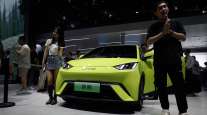The Detroit News
NTSB’s Homendy Expected to Be a Tesla Watchdog

Federal regulators last month officially opened an investigation into crashes involving Tesla Inc.’s Autopilot system. Jennifer Homendy, the new leader of the government’s transportation safety watchdog, hopes that’s just the beginning.
The 49-year-old was sworn in Aug. 13 as the new leader of the National Transportation Safety Board, an independent agency responsible for investigating transportation accidents and issuing recommendations to improve safety.
For years, the board has raised alarms about problems with driver monitoring and marketing for low-level automation in cars, technology known as advanced driver assistance systems (ADAS) that can help drivers navigate traffic but requires them to be fully alert at all times.
Homendy has been one of the most vocal critics on the NTSB, taking Tesla to task on Twitter and pushing the National Highway Traffic Safety Administration — the agency with enforcement power over auto safety — to take action to ensure the technology is used safely. Now as the board’s leader, she’s expected to use its powerful voice in Washington to continue that drumbeat.
“People listen because they know we’re fact-based, they know we’re thorough, they know the reputation of our investigators,” she said in an interview with The Detroit News. “They know that we come forward with what the right thing is to do to prevent that crash — not just what we thought we could get accomplished given a cost-benefit analysis.”
Over the past five years, NHTSA has looked into more than two dozen Tesla crashes that have injured 17 people and killed one. The crashes have prompted criticism from safety advocates and industry experts that the company is overstating the vehicles’ self-driving capabilities and potentially endangering the lives of its customers.

A Tesla sedan in Autopilot mode crashed into a parked police cruiser in Laguna Beach, Calif., in May of 2018. The officer was not in the car at the time of the crash; the Tesla driver suffered minor injuries. (Laguna Beach Police Department via Associated Press)
As the crashes piled up, the NTSB urged NHTSA to create standards for driver assistance tech, include it in federal new car testing, and investigate misuse of Tesla’s systems in particular, among other things. Tesla did not respond to multiple requests for comment for this story.
The agency’s recently announced investigation into 12 Teslas crashing into emergency vehicles is “a really positive step forward,” Homendy said, but she plans to keep the pressure on. The agency still hasn’t implemented most of the board’s recommendations.
“There needs to be more” done to make driver assistance tech safe, she said. “There’s a lot of discussion going on right now about innovation and investment in transportation. But there’s not a very large focus on safety, and I think we play a big role in that.”
A public voice
Tesla’s Autopilot system can steer, brake, accelerate and change lanes on its own. Ford Motor Co., General Motors Co. and other automakers have similar ADAS programs in some of their vehicles.
Tesla also has been selling add-ons for up to $10,000 to use the beta version of its “Full Self-Driving” program, which is also an advanced driver-assistance system, on public roads.
Cars with ADAS cannot drive themselves, and there are no fully autonomous vehicles available to consumers in the U.S. today. But that hasn’t stopped some Tesla fans from taking chances, posting videos of people sleeping, playing video games or sitting in the backseat of a Tesla while their vehicles drive on the highway.
Critics and safety advocates have argued that CEO Elon Musk has overstated the capabilities of Autopilot and Full Self-Driving, encouraging reckless behavior, and have lampooned NHTSA for not doing more to investigate the dozens of crashes related to Tesla vehicles. Musk has argued the company is clear about the vehicles’ capabilities.
Homendy has been one of those speaking out.
"Full self-driving" suggests that the vehicle can drive itself right now, without input from a human operator. That's not true. There should be safeguards in place to prevent such deceptive claims. Where's @NHTSA? 3/4 — Jennifer Homendy (@JenniferHomendy) December 29, 2020
“‘Full self-driving’ suggests that the vehicle can drive itself right now, without input from a human operator. That’s not true. There should be safeguards in place to prevent such deceptive claims. Where’s NHTSA?” she wrote on Twitter late last year.
“NHTSA’s mission is to first and foremost save lives. Tech can improve safety across all modes of transportation, but not when innovation takes precedence,” Homendy wrote. “If auto manufacturers are misleading consumers, regulators need to step in and take action before more lives are lost.”
Her willingness to use social media to call out automakers and government inaction makes Homendy a unique voice on the NTSB, whose other members are either absent from or more reserved on Twitter, said David Zipper, a fellow at the Harvard Kennedy School’s Taubman Center for State and Local Government.
“Twitter is a legitimate platform to get messages out,” Zipper said. “I think it’s pretty obvious what she’s looking for and where her thoughts lie with regards to Tesla.”
Last week, NHTSA demanded Tesla turn over a wealth of data on how its Autopilot system works by late October. The agency’s investigation covers 12 crashes, but could impact 765,000 Tesla vehicles built between 2014 and 2021 if the agency determines a recall is necessary.
Meet Jennifer Homendy, the new leader of a safety board that has been pushing the federal government to take a tougher stance on driver-assistance tech: https://t.co/MbblCnURku — Riley Beggin (@rbeggin) September 7, 2021
The pace and scope of the investigation may be an indicator that NHTSA and NTSB are entering an era of “alignment, coordination and support” rather than “increasing exasperation,” Zipper said.
“It’s been percolating for a while,” he said. “There’s been a growing realization that something is fundamentally wrong here. This is not OK to let automakers try out whatever they like on public roads, and in the process potentially put people at risk.”
Dogged pursuit
While Homendy is glad to see NHTSA beginning to investigate issues with Tesla, she says more needs to be done to improve semi-autonomous tech already on the road.
Advanced driver-assistance systems are readily available, she said, “yet we’re kind of skipping over that and focusing on what’s in the future, when technologies that could prevent fatalities and injuries now are no longer the focus. It’s always, ‘OK, what’s the next thing down the road.’”

Fleet managers find that healthy, happy drivers are key to business success. Stephen Kane of Rolling Strong says driver health starts with “being vulnerable enough to listen to somebody that knows about health.” Hear a snippet above, and get the full program by going to RoadSigns.TTNews.com.
NTSB has issued several recommendations to NHTSA, including expanding the New Car Assessment Program to test crash avoidance systems, developing safety standards for monitoring motorists using ADAS to make sure they keep their eyes on the road, and enacting more stringent requirements to prevent distracted driving.
The government should also develop guidelines for marketing driver-assistance systems, she said, adding that message should apply to all automakers, not just Tesla. “The public has a right to know what their vehicle does and does not do, and should be fully educated on that. I’d submit that’s not really happening right now.”
How NHTSA responds could have a wide-ranging impact on the industry: how it will develop autonomous vehicles, and whether the public trusts AVs, said Zipper.
NHTSA told The Detroit News via email it is “pleased to work with NTSB” and welcomes the agency’s input on safety recommendations. “Safety is central to NHTSA’s mission and we are committed to improving safety for all road users.”
Homendy joined the NTSB in 2018 after spending 14 years working as the Democratic staff director of the U.S. House Transportation and Infrastructure Committee’s Subcommittee on Railroads, Pipelines and Hazardous Materials. Before that, she was a legislative representative for the International Brotherhood of Teamsters and the AFL-CIO’s transportation trades department.

Then an NTSB board member, Homendy briefs the media about the helicopter crash that killed NBA star Kobe Bryant and eight others in January 2020. (Damian Dovarganes/Associated Press)
In the years since joining the agency, Homendy has gained a reputation for being a dogged safety advocate, said Jason Levine, executive director of the Center for Auto Safety. “There’s no doubt of the sort of continued relentless attitude she’s going to bring to the position. She will not simply give up if at first there’s limited success in convincing those of regulatory authority to act.”
That’s how Homendy, too, sees the role. She remembers, when she was working with Congress, being inspired by NTSB advocates fighting for 50 years to spur changes to train regulations.
“It’s unheard of for an agency to be after something for 50 years. It’s great because they didn’t give up,” she said. That’s especially important for an agency like NTSB with no power to make its own recommendations reality.
“It can certainly be frustrating to be on scene when (crashes are) repeated,” she said. “But we have the facts on our side, and all we want to do is improve safety and make sure that lives are saved.”
Distributed by Tribune Content Agency, LLC




